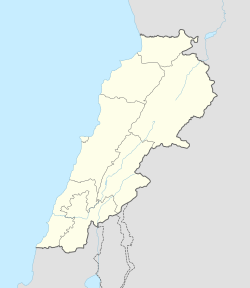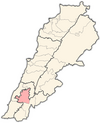|
Kfar Tebnit
Kfar Tebnit or Kfartebnit (Arabic: كفرتبنيت) is a municipality located approximately 4 kilometres (2.5 mi) south southeast of Nabatieh, 37 kilometres (23 mi) southeast of Sidon in Lebanon. EtymologyKfar Tebnit takes its name from Tabnit, a Phoenician ruler in the area ca. 280 BC known as the "king of two Sidons". The sarcophagus of his son Eshmun-'azar was found to bear a long inscription aimed to prevent looting with assurances that the tomb contained no treasure.[1] ArchaeologyA Heavy Neolithic archaeological site of the Qaraoun culture was discovered here in 1926 by E. Passemard . Heavy Neolithic materials were found alongside one Trihedral Neolithic along with more regular Neolithic pieces. The tools were in sharp condition, made of fresh chert or grey-green flint and are stored in the National Museum of Beirut.[2] HistoryIn 1875 Victor Guérin visited, and found here 130 Metualis.[3] The Ottoman mosque of the village was totally destroyed as a result of the Israeli attacks in October 2024 in southern Lebanon.[4][5] DemographicsIn 2014 Muslims made up 99.86% of registered voters in Kfar Tebnit. 98.02% of the voters were Shiite Muslims.[6] References
Bibliography
External links
Information related to Kfar Tebnit |
||||||||||||||||||||||||||||||||||||||

